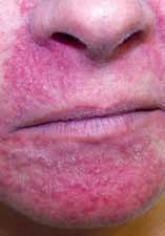Article

Diagnosis at a Glance: Cases in Dermatology
- Author:
- A.J. Himmelsbach, NP
- Stephen Schleicher, MD
- Jamie Remaley, PA-C
Article
Rash on a Man's Hand; Itchy Lower-Body Lesions on a Woman
- Author:
- Roodabeh Samimi, DPM
- Stephen M. Schleicher, MD
- A.J. Himmelsbach, NP
A 34-year-old man requests evaluation of a rash affecting his dorsal proximal right thumb and right wrist. A 35-year-old woman presents for...
Article
An Erythematous Plaque With a Clear Center, and a Case of Back Excoriations
- Author:
- Stephen M. Schleicher, MD
- A.J. Himmelsbach, NP
- Roodabeh Samimi, DPM
Can you find the underlying cause for each of these conditions?
